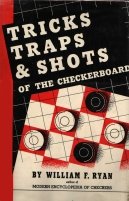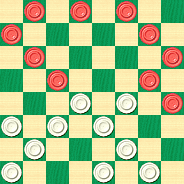The Jaywalker Gambit

If you visit Honolulu, you'd best not jaywalk; the fine is a whopping one hundred and thirty dollars, and the police don't hesitate to hand out the tickets. Jaywalking is a gambit you won't want to risk; it could really cost you.
There's a Jaywalker Gambit in checkers, too, and it won't cost you a cent to hear how Willie Ryan describes it in his classic book, Tricks Traps & Shots of the Checkerboard.

"The late great A. J. Heffner, of Boston, former Champion of America and heralded as one of the greatest analysts of all time, was responsible for christening the following trap 'the Jaywalker,' pointing out that many experts had wandered into it, unaware of their predicament until it was too late to bail out. The Jaywalker, a formational 'natural,' was originally rated drawable on the basis of Tillum and Aitchison's play, as quoted in the trunk game. But the eminent British authority, J. A. Kear, of Bristol, England, published an analysis indicating that, by introducing the 16-19 move at Note E, the gambit ended in defeat. Kear's play remained unchallenged for many years, but the data assembled here indicate that Kear's 16-19 move is nothing more than a transposition that ultimately runs back into the Tillum and Aitchison draw. Play:
| 11-16 | 30-26 | 7-10 |
| 24-19 | 11-16 | 26-22---2 |
| 8-11 | 22-17---A | 10-14, |
| 22-18 | 4-8 | forming the |
| 10-14 | 17-10 | diagram. |
| 26-22 | 6-24 | |
| 16-20 | 28-19 | |

WHITE
White to Play and Draw
W:W32,31,29,27,25,23,22,21,19,18:B20,16,14,12,9,8,5,3,2,1.
A---A very weak move---1, forming the famous Jaywalker position. The correct play here for a draw is: 28-24, 4-8, 22-17, 7-10, 26-22, 3-7---B, 19-15, 10-26, 17-3, 26-30, 18-15, 6-10, 15-6, 1-10, 31-26, 30-23, 27-18, 20-27, 32-23, 9-13, 21-17, 5-9, 25-21, 2-7, 29-25, 7-11, 3-7, 10-14, 17-10, 16-20, 7-16, 12-26. Wm. F. Ryan.
B---White has a pretty trap here, for if the play goes 9-13, 18-9, 5-14, white wins by storm with: 19-15!, 10-26, 17-10, 6-15, 22-17, 13-22, 25-4, 26-30, 4-8. D. G. McKelvie."
1---The computer sees 22-17 as only very slightly worse than 28-24, so we're not sure why Willie thinks it's so weak. Perhaps the position is simply more difficult to play correctly---Ed.
2---Here's the real problem. The text move is substantially weaker than 25-22, though still not losing. Perhaps Willie should have flagged this move instead---Ed.
Don't be a jaywalker; walk the straight and narrow and solve the position. But we won't fine you if you don't get it; you can always safely click on Read More to see the solution and detailed notes.![]()
Solution

WHITE
White to Play and Draw
W:W32,31,29,27,25,23,22,21,19,18:B20,16,14,12,9,8,5,3,2,1.
"Continue:
| 22-17*---C | 23-14 | 17-13 | 25-22* | 27-23 |
| 2-6 | 1-6 | 6-10 | 10-14 | ending in |
| 17-10 | 25-22 | 14-7 | 22-17 | a draw. |
| 6-24 | 16-19---E | 3-10 | 14-18 | Tillum |
| 18-14 | 22-17---F | 29-25* | 32-28* | and |
| 9-18 | 8-11---H | 11-15 | 18-22 | Aitchison. |
C---Not wishing to allow the two for one that follows this move, many champions have fallen here, by going 19-15, which loses to black like this: 19-15, 16-19, 23-16, 14-23*, 27-18, 12-19, 15-11, 8-15, 18-11, 9-14*, 31-26---D, 5-9, 22-17, 14-18, 25-22, 18-25, 29-22, 20-24, 22-18, 24-28*, 18-15 (if at this point 17-14 or 17-13 is moved, black wins with 19-23, 26-19, 3-7), 19-24*, 26-22, 9-13, 17-14, 3-7. Wm. F. Ryan. Another losing move at C is 27-24, which must be countered correctly, like this: 27-24, 20-27, 31-24, 16-20, 32-27, 8-11*, 19-15, 11-16*, 24-19 (if 15-10 or 15-11 is now played, white is finished with 16-19, 24-15, 12-16), 9-13*!, 18-9, 5-14, 22-17, 13-22, 25-9, 1-5, 9-6, 2-9, 15-10, 9-14, 19-15, 16-19, 23-16,12-19,10-6,14-18, 6-2,19-24, and black wins. Wm. F. Ryan.
D---If 22-17 is taken, black wins with: 14-18, 25-22, 18-25, 29-22,19-23, 22-18, 5-9*!, 17-14 (17-13, 3-7,13-6, 7-16, black wins), 1-5, 14-10, 9-14, 18-9, 5-14. D. C. Calvert.
E---When this position first came under the scrutiny of the experts, black's best attack was considered 8-11 here, against which white gains a draw with: 29-25, 6-10, 14-7, 3-10, 21-17, 11-15, 17-13, 10-14, 25-21, 16-19, 32-28; the draw shown in trunk. But, apparently, J. A. Kear did not think well of this play, offering 16-19 to win.
F---The only move to draw, correcting Kear's play, which goes 32-28 (loses), 8-11---G, 29-25, 3-7; now Kear's play is 22-18, allowing a fast win by 6-9; but instead of using 22-18, try 22-17, 6-10, 17-13, 10-17, 21-14, 19-23, 27-18, 24-27, 31-24, 20-27, 28-24, 27-31, 24-19, 11-16, 19-15, 16-20, 13-9, 31-26, 9-6, 26-23, 15-10, 7-11, 10-7, 23-26, 7-3, 26-22, 3-8, 22-15, 14-10, 11-16, 6-1, and black's win, if any, is very problematical.
G---Black can win at once here, by 3-7 *, 29-25 (22-17, 6-9 wins),
6-9, 21-17, 9-18, 22-15, 5-9. Wm. F. Ryan. This improves upon and in fact nullifies Kear's play.
H---If the sequence of play is: 6-10, 14-7, 3-10, 17-14, etc., white picks up an easy draw. If it is: 6-9, 14-10, 9-14, 10-6, 14-18, 29-25, etc., the result is the same. If the move is 3-7, 17-13* draws as in trunk, but if 29-25 is moved instead of 17-13* (after 3-7), then the draw is uncomfortably close against the following play: 6-9, 14-10, 7-14, 17-10, 9-14, 25-22, 5-9 (threatening 19-23), 32-28, 8-11, 10-6, 9-13, 6-2, 11-15, 27-23, 19-26, 28-10, 26-30, 31-26 *, 30-23, 22-18. Wm. F. Ryan. A noteworthy pitch-and-pinch play."
Editor's Note: In our opinion this problem was pretty challenging, and the solution admits of numerous variations. It's a good one to explore with your computer.
You can email the Webmaster with comments on this article.